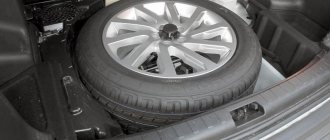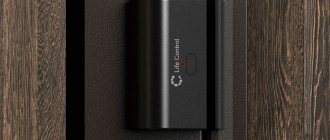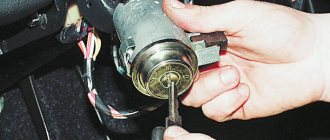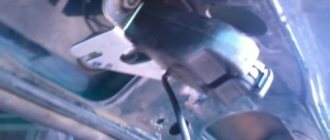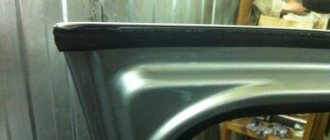Types of locks
By type of key:
- cylinder - with a small key with protrusions and notches;
- level key – a long key with “wings” on the edges;
- Phillips - with a key similar to a Phillips screwdriver;
- disk - the key is small and semicircular with notches.
By type of insert:
- the overhead lock is installed on the door leaf, closed with a key from the outside, and a latch from the inside;
- mortise is built inside the door, the handle controls the tongue;
- A padlock is installed separately from the locking element and is used for garage doors or gates.
The most popular are mortise lever locks.
Causes of problems
The most common difficulties:
- The tongue cannot close. The source of the problem is the small size of the response hole. It needs to be enlarged or the plate moved a little. Another reason could be a door that is warped due to frequent use. The mechanism wears out and needs to be adjusted.
- Difficulty opening the door when it is blocked due to a misaligned lock or door frame. In this case, the problematic part is adjusted.
- The key gets stuck, is difficult to turn, or cannot be inserted. This is more common on metal doors. This happens due to debris getting into the lock or some of its parts shifting. To get rid of the problem, it is disassembled, cleaned and lubricated.
- The lock is jammed - there is a problem with the condition of the cylinder. The seal needs to be repaired or replaced. In some cases, it is better to install a new lock if the old one is worn out and ancient.
Other reasons for problems with the lock:
- factory defects in the mechanism;
- rare washing and lubrication;
- using the key for other purposes (opening a bottle, packaging);
- frequent opening of the door with force;
- worn parts in the lock;
- duplicate key of poor quality;
- incorrect initial installation of the lock;
- a wooden door can become damp and swell.
Major lock failures
The main requirements for a door lock are reliability, long service life and burglary resistance. The locking devices used in high-quality entrance doors fully comply with each of the listed conditions. However, even the most reliable and durable mechanisms can periodically fail. The most common malfunctions are the following:
- difficulties with inserting or turning the key in the well on one side or both;
- the key cannot be pulled out of the lock;
- the bolts of the locking device do not respond to turning the key, as a result of which the door does not close - on both sides, from the inside or outside;
- the lock is jammed, while the key is inserted into the hole;
- when the locking device is activated, creaking or other extraneous sounds are heard;
- the key has broken in the keyhole, and its fragment cannot be removed and prevents further use of the mechanism.
The situations described arise for various reasons. Their identification is a key and often the most important stage in repairing a locking device, as it allows you to choose the optimal way to fix the problem. In most cases, lock failure occurs due to:
1. Problems with the key. In this case, we are talking not only about a banal breakdown, but also about severe wear or production of a low-quality duplicate, as well as the use of a non-original key;
2. Lack of regular maintenance of the mechanism. It is recommended that each locking device be inspected and lubricated at least once a year. For external doors that are used in more difficult conditions, maintenance is required every six months, more often in the cold calendar period;
3. Foreign objects, debris and dirt getting inside the well or secret mechanism. This problem can also be eliminated by periodic maintenance of the locking device;
IMPORTANT. A significant part of problems with door locks are successfully solved at the initial stage of their occurrence. There is no need to wait for the mechanism to completely fail. It is much more correct to quickly eliminate the problem when its first signs are identified - difficulties with turning the key, extraneous sounds when closing the door, etc. This approach will save money and avoid expensive repairs or even replacement of the mechanism.
4. Incorrect position of the leaf in the door frame or the frame itself in the opening. Misalignment of the entrance structure can be caused by installation errors, deformations, as well as operation of the door in unsuitable conditions. The result is problems that are not directly related to the mechanism, but interfere with its normal operation;
5. Wear or failure of individual parts of the locking device. This is a consequence of long-term use of the product. As in most similar situations, it is extremely important to identify the problem earlier, which will avoid the unpleasant need to open or break into the lock product, and in case of unfavorable developments, the entire entrance structure;
IMPORTANT. The most difficult solutions to the problem relate to entrance doors. Interior structures are equipped with simpler locking devices, which are much easier to repair, replace and break into.
6. Attempts of unauthorized entry into the premises. In such a situation, we are talking not only about the actions of attackers, but also about the use of another key or an auxiliary tool not intended for this purpose to open the locking product. Such actions often damage the device, and repair of the mechanism is not always possible.
How to open a door if the lock is jammed
The main rule: if you can’t open the door, you don’t need to apply even more force. There will be no sense from this, and the situation could get even worse.
You can try to open the door yourself using available tools: a hairpin, wire, screwdriver, pliers, grinder, crowbar, drill. If you can’t do this yourself, you should call a locksmith, the Ministry of Emergency Situations, or an employee of a company specializing in opening locks.
When the tongue is jammed, a knife, an aluminum ruler or an old plastic card will come to the rescue. Insert a thin, hard object between the box and the canvas where the tongue is located. Press down slowly until it goes in far enough to catch the far side of the tongue. Then you need to force it out of the hole, this will require a little force.
If the lock is cylinder type
When the cylinder is jammed or the key is stuck, you need to clean the hole with a wire brush. There may be too much dust or paint peeling off the door. After this, the lock is lubricated with machine oil or kerosene. If this does not help, you need to drill out the lock cylinder and install a new one.
If the door leaf is warped, you need a lever: a chisel, a screwdriver or a wedge. It is driven into the problem area and the door is installed in its place. At the same time, the handle is pulled to open it.
If the lock breaks, it is necessary to remove the cylinder when the mechanism is drilled out. You can place some suitable hard object against the cylinder and knock it out with a hammer. Then, when using a metal hook, you must try to move the opening mechanism.
Cross variety
You need to chew the gum well and place it inside the castle. After this, insert a screwdriver and turn it. The chewing gum will take the shape of a key and help open the door.
If the type of lock is level
If the key jams after 3 turns and it is not possible to make the 4th, it is necessary to grind off the longitudinal protrusions. They prevent the key from positioning correctly. After this, you need to insert the key with the back side and try to open the door. When there is nothing at hand to grind, the hole in the lock is pressed out and the key is inserted with the other side.
After this, if you manage to open the door, you need to remove the lock, disassemble it and clean every part. Lubricate them separately with a silicone-based product and assemble the lock.
How to solve a problem
The method for eliminating the problem depends on what caused it. Each situation requires an individual approach and choice of further actions.
Deformation of the entrance structure
First you need to check if the door frame is warped. You can understand this by using a building level. If this is the reason, to correct the situation you need to:
- remove the door from its hinges;
- disassemble the platbands and remove all excess underneath them for direct access to the box;
- level the structure using wooden wedges;
- if necessary, foam the voids;
- After the foam has dried, reassemble the system.
In addition, you can adjust the box by loosening and tightening the anchor bolts that hold it in the opening.
If the lock mechanism does not close because the door is swollen, you need to act differently. It is better to replace a severely damaged blade. If the deformation is not so significant, you can take the following actions:
– remove the door from its hinges;
– use a plane to remove the resulting irregularities;
– treat the resulting surface with varnish;
– install the structure in place.
IMPORTANT! This method can only be used if the canvas is made of natural wood. In this case, products made from chipboard and MDF will be damaged.
The tongue does not fit into the groove
If a situation arises when the tongue does not fit into the reciprocal groove or fits into it very tightly, you can solve the problem by widening the hole in the door frame. To do this, you need to remove the bar, drill out the groove with a drill and put the part in place, moving it a little. When it comes to a metal structure, you can bore the hole with a file.
If this problem appears after a long period of use of the door, the door leaf is most likely sagging. This can be determined by its upper edge. In this case, it will not be parallel to the box. You can also cope with this situation on your own. To do this, you need to remove the product from its hinges and see what the reason is. It could be:
– loose fasteners;
– deformed hinges.
In the first case, it is best to seal the existing holes and install thicker and longer screws. In the second situation, you will have to change the loops.
Garbage got inside
If the reason that the lock does not close is that it is clogged, it is necessary to clean the well. To do this, manufacturers offer special liquids that must be poured or injected into the mechanism. They dissolve the blockage and remove dirt out. After this, you need to insert the key into the hole several times, move it from side to side and wipe off any deposits that have appeared on the surface.
If this method does not help, you will have to disassemble the system and clean it. The sequence of actions differs slightly depending on the type of device installed. If the cylinder mechanism is embedded, it is enough to pull out the cylinder. In the case of a lever system, you will have to disassemble the entire product.
To disassemble the cylinder device, you need:
- remove the decorative overlays from the canvas and unscrew the fastenings under them;
- unscrew the screws holding the device from the end of the door;
- using the key, turn the core to a position where the leash is aligned with the lock body;
- Press the cylinder with your finger and remove it.
When dealing with a lever lock, you should take the following steps:
- set the mechanism to the open position;
- remove the covers and unscrew the screws underneath them;
- remove the fastener from the end of the blade;
- pull out the steel rod and lock.
After this, you need to clean the mechanism from dirt using a toothbrush and a rag. Then you should lubricate the device with special compounds, for example, WD-40 or machine oil.
Wear of parts
During operation, not the entire lock, but some of its parts may deteriorate. You can correct the situation by disassembling the mechanism and inspecting it for the cause of the breakdown. How to remove the device from the door was discussed in the previous paragraph. Next, you need to open access to the internal components of the lock and find the broken part. Buy an analogue for replacement in a specialized store. After replacing the part, reassemble the product and install it back.
IMPORTANT! When disassembling the lever lock, you need to remember that all the levers are located in a certain order. If it is broken, it will be impossible to open or close the mechanism. Therefore, when disassembling the device, you should number the levers with a marker.
Other problems
If the new lock cannot be closed, it is most likely due to a manufacturing defect. In this case, you should contact the seller of the mechanism and demand that the device be replaced with a new one. Official manufacturers provide a guarantee for their products.
If the key is damaged, you should use a spare one. Most locking mechanisms come with 3 to 5 keys. If this is not possible, you can contact a craftsman who will make a duplicate using a cast or lock cylinder.
What to do if the key gets stuck
First of all, you need to treat the mechanism with silicone spray and carefully, slowly, remove the key. If this method does not help, the key needs to be clamped with pliers and loosened a little. After this, spray some liquid inside again and carefully turn the key again.
Advice:
After spraying the liquid, you should move the wrench a little to maximize the distribution of the lubricant, wait about 20 minutes and only then take out the wrench.
If this is successful, it is necessary to change the cylinder or lock, otherwise the situation may repeat. If there are no problems when the door is open, but when the door is closed the key gets stuck, the door frame must be bored. A grinder, drill or file is suitable for this.
The key is broken in the lock
What to do if the key inside the lock breaks:
- Try to pull it out with pliers if a small piece sticks out.
- Use a jigsaw if the key is far inside. Send the jigsaw blade into the keyhole from below and twist it to engage the key. Try to carefully pull it out along with the rest of the key.
- When you cannot get the key, unscrew the lock and remove it.
Preventative measures - how to protect the lock from jamming
What to do when purchasing:
- before purchasing a door, check what type of lock it will be and whether there is a guarantee;
- ask about the country of production - high-quality locks are made in Austria and Germany, you can also take Polish, Turkish or Ukrainian;
- In the store, check the ease of movement of the tongue;
- There should be no rust, scuffs or scratches on the lock.
How to care for the mechanism:
- periodically clean from dust and dirt, lubricate;
- turn the key only after it is fully inserted;
- do not use keys of poor quality or damaged;
- You can use machine oil for lubrication;
- the best lubricant is silicone, it has a long-lasting effect and also repels water, preventing the mechanism from rusting;
- correct the distortion of the door leaf or frame, even if the lock is still functioning normally;
- open the door by the handle, no need to pull the key, which is still inside;
- Do not slam the door sharply or forcefully.
Important:
Do not lubricate the lock with edible vegetable oil. It absorbs all the dirt and dust and can ruin the mechanism. When the oil thickens, you can open the door with almost any key - this is the method used by thieves.
In order not to waste time and money (on repairing the lock or a new one, on calling a locksmith), you need to handle the lock carefully. If you open it with gentle, smooth movements and do not use force, it will last a long time.
Reasons for poor closing of a steel door
Of course, a situation where the entrance metal door does not close well requires surgical intervention. This is quite logical and has an extremely simple explanation. If the problem further worsens, the structure will simply not be able to be closed one day, leaving the housing unprotected. Obviously, to correct the problem, you must first find out the reasons for its occurrence. It is often possible to install them even without inviting specialists. The most common situations in practice are:
- Installation of low-quality locking devices or lack of maintenance. As a result, there is a gradual deterioration in the operation of the lock, for example, instead of 4 turns of the key, only 2 can be made, or serious effort is required to close, etc.
- Wear of seals or, on the contrary, installation of new, thicker ones. Often when repairing a steel door, various parts are replaced. Often this involves installing new profile seals. This leads to the fact that the process of closing the door is seriously complicated. This situation is one of the few that can be corrected even without intervention, just after some time;
- Warping of the door leaf. This often happens when the sash is hung on two hinges or insufficiently strong fittings are used. In most cases, if prompt measures are not taken to correct the situation, after some time the door will stop closing altogether;
Deformation of the entrance structure. There can be many reasons for this development of events. These are insufficient strength and load-bearing capacity of the opening, errors in the design or manufacture of the product, as well as the use of low-quality fittings. As a result, the lock of the entrance metal door does not close properly due to the fact that the bolts do not fit into the grooves of the locking device post.
Of course, there are other factors that can cause a door to close poorly, such as slamming the door tightly for a long time. In this case, due to severe shock loads, deformation of the structure or destruction of any parts may occur. In any case, for effective further use of the product, it is almost always necessary to take action to repair or adjust it.
